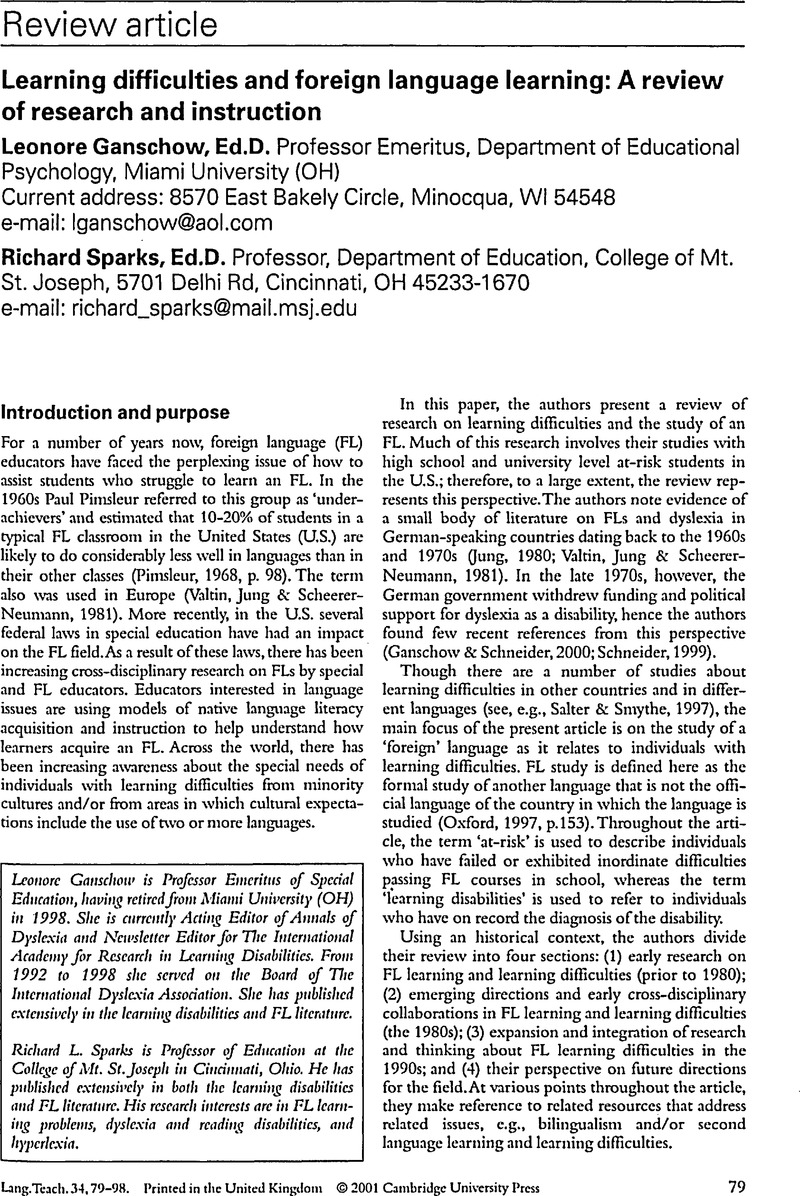Crossref Citations
This article has been cited by the following publications. This list is generated based on data provided by Crossref.
Sparks, Richard L.
Philips, Lois G.
and
Javorsky, James
2002.
Students Classified as LD Who Received Course Substitutions for the College Foreign Language Requirement.
Journal of Learning Disabilities,
Vol. 35,
Issue. 6,
p.
482.
Sparks, Richard L.
Philips, Lois
and
Javorsky, James
2003.
Students Classified as LD Who Petitioned for or Fulfilled the College Foreign Language Requirement—Are They Different?.
Journal of Learning Disabilities,
Vol. 36,
Issue. 4,
p.
348.
Butzkamm, Wolfgang
2003.
We only learn language once. The role of the mother tongue in FL classrooms: death of a dogma.
The Language Learning Journal,
Vol. 28,
Issue. 1,
p.
29.
Sparks, Richard L.
Javorsky, James
and
Philips, Lois
2004.
College Students Classified with ADHD and the Foreign Language Requirement.
Journal of Learning Disabilities,
Vol. 37,
Issue. 2,
p.
169.
Sparks, Richard L.
Ganschow, Leonore
Artzer, Marjorie E.
Siebenhar, David
and
Plageman, Mark
2004.
Foreign Language Teachers' Perceptions of Students' Academic Skills, Affective Characteristics, and Proficiency: Replication and Follow‐up Studies.
Foreign Language Annals,
Vol. 37,
Issue. 2,
p.
263.
Sparks, Richard L.
Javorsky, James
and
Philips, Lois
2005.
Comparison of the Performance of College Students Classified as ADHD, LD, and LD/ADHD in Foreign Language Courses.
Language Learning,
Vol. 55,
Issue. 1,
p.
151.
Sparks, Richard L.
2006.
Is There a “Disability” for Learning a Foreign Language?.
Journal of Learning Disabilities,
Vol. 39,
Issue. 6,
p.
544.
Sparks, Richard L.
Patton, Jon
Ganschow, Leonore
Humbach, Nancy
and
Javorsky, James
2006.
Native language predictors of foreign language proficiency and foreign language aptitude.
Annals of Dyslexia,
Vol. 56,
Issue. 1,
p.
129.
Sparks, Richard L.
and
Ganschow, Leonore
2007.
Is the Foreign Language Classroom Anxiety Scale Measuring Anxiety or Language Skills?.
Foreign Language Annals,
Vol. 40,
Issue. 2,
p.
260.
Sparks, Richard L.
2008.
Evidence–Based Accommodation Decision Making at the Postsecondary Level: Review of the Evidence for Foreign Language Learning.
Learning Disabilities Research & Practice,
Vol. 23,
Issue. 4,
p.
180.
DiFino, Sharon M.
Johnson, Bonnie W.
and
Lombardino, Linda J.
2008.
The Role of the SLP in Assisting College Students With Dyslexia in Fulfilling Foreign Language Requirements: A Case Study.
Contemporary Issues in Communication Science and Disorders,
Vol. 35,
Issue. Spring,
p.
54.
Sparks, Richard L.
Humbach, Nancy
and
Javorsky, James
2008.
Individual and longitudinal differences among high and low-achieving, LD, and ADHD L2 learners.
Learning and Individual Differences,
Vol. 18,
Issue. 1,
p.
29.
Schneider, Elke
and
Evers, Tsila
2009.
Linguistic Intervention Techniques for At‐Risk English Language Learners.
Foreign Language Annals,
Vol. 42,
Issue. 1,
p.
55.
SPARKS, RICHARD L.
PATTON, JON
GANSCHOW, LEONORE
and
HUMBACH, NANCY
2009.
Long-term relationships among early first language skills, second language aptitude, second language affect, and later second language proficiency.
Applied Psycholinguistics,
Vol. 30,
Issue. 4,
p.
725.
Sparks, Richard L.
2009.
If You Don't Know Where You're Going, You'll Wind up Somewhere Else: The Case of “Foreign Language Learning Disability”.
Foreign Language Annals,
Vol. 42,
Issue. 1,
p.
7.
Sparks, Richard
Patton, Jon
Ganschow, Leonore
and
Humbach, Nancy
2009.
Long‐Term Crosslinguistic Transfer of Skills From L1 to L2.
Language Learning,
Vol. 59,
Issue. 1,
p.
203.
Surkamp, Carola
2010.
Metzler Lexikon Fremdsprachendidaktik.
p.
158.
Schwab, Götz
2011.
From dialogue to multilogue: a different view on participation in the English foreign‐language classroom.
Classroom Discourse,
Vol. 2,
Issue. 1,
p.
3.
Aragão, Rodrigo
2011.
Beliefs and emotions in foreign language learning.
System,
Vol. 39,
Issue. 3,
p.
302.
SPARKS, RICHARD L.
HUMBACH, NANCY
PATTON, JON
and
GANSCHOW, LEONORE
2011.
Subcomponents of Second-Language Aptitude and Second-Language Proficiency.
The Modern Language Journal,
Vol. 95,
Issue. 2,
p.
253.



